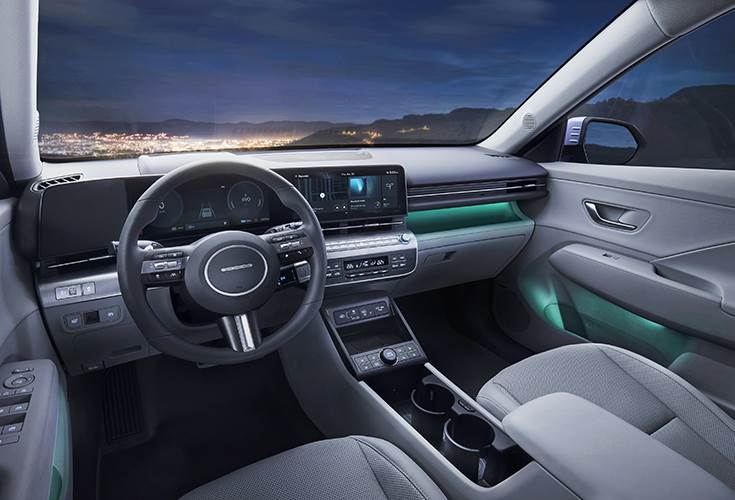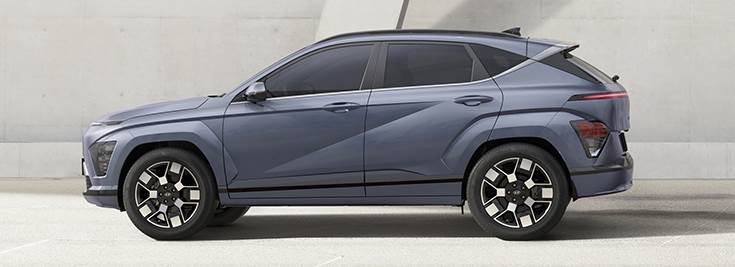Hyundai Motor Company today held a digital world premiere to unveil the all-new Kona, led by an all-electric variant (EV) that offers advanced safety and convenience features and class-leading range of 490km on a single charge.
The second-generation Kona offers one of the most comprehensive product packages in the B-SUV segment, including the widest range of powertrains. Customers can choose from EV (standard or long range), hybrid electric (HEV) and internal combustion engine (ICE) variants as well as sporty N Line versions of each.
In an unconventional move, Hyundai has developed the new Kona as an EV first, in line with the company’s March 2022 accelerated electrification strategy announcement that will bring 11 new Hyundai EVs to market by 2030. For the all-new Kona, Hyundai Motor broke away from the conventional ICE-to-EV development process and followed an EV-to-ICE process, resulting in a futuristic EV-centric exterior that accentuates the SUV’s pure volume to make a rugged and dynamic impression.
“Kona Electric will play a major role alongside our Ioniq models in reinforcing Hyundai’s EV leadership. At Hyundai, we don’t see the EV revolution as just the latest trend. We believe it is a pivot point for not only the industry but also for society,” said Jaehoon Chang, President and CEO, Hyundai Motor Company.
Among the upgrades for the all-new Kona are dual 12.3-inch panoramic display screens, a Digital Key 2 Touch, full Over-the-Air (OTA) updates and Connected Car Navigation Cockpit (ccNC).
Equipped with a long-range 65.4-kWh battery, the Kona Electric delivers WLTP-estimated 490km all-electric range. It also comes with EV-specific design elements, including frunk storage, active air flaps, interior and exterior Vehicle-to-Load (V2L) outlets, Head-up Display (HUD), i-PEDAL driving mode, Smart Regenerative System, electronic-Active Sound Design (e-ASD) and an Eco Package.
 New Kona is 4355mm long, 175mm longer; 2660mm wheelbase is 60mm longer; width at 1825mm is 25mm more, and 20mm taller at 1575mm.
New Kona is 4355mm long, 175mm longer; 2660mm wheelbase is 60mm longer; width at 1825mm is 25mm more, and 20mm taller at 1575mm.
The second-gen Kona is high on safety with Hyundai’s SmartSense Advanced Driver Assistance System (ADAS) and safety systems, including Level 2 autonomous driving, Forward Collision Avoidance Assist (FCA), Blind-spot View Monitor (BVM), Remote Smart Parking Assist (RSPA) and Driver Status Monitor (DSM).
Compared to the previous generation Kona, the new model has unique proportions with increased dimensions. Based on the EV variant, its length is now 4,355mm, 175mm longer than the previous generation in 2017, with a wheelbase of 2,660 mm, which is 60mm longer. Width is 1,825mm, which is 25mm wider, and the height is 20mm taller at 1,575mm.
 Aiming to be ace of EV space
Aiming to be ace of EV space
Based on the model’s upscaled dimensions and EV-derived universal architecture, Hyundai Motor was able to design a larger interior ‘living space’ to embrace a wider range of lifestyles. The driver-centric front row is accentuated by a floating horizontal C-Pad with integrated dual 12.3-inch panoramic display screens that affirm the Kona’s high-tech character.
As part of the Kona’s new layout, the shift-by-wire gear selector has been relocated from the centre console to behind the steering wheel, which allows more storage in the open console area. The layout also emphasises the EV’s larger, wider interior, providing a versatile and comfortable space for driver and passengers. This impression is further reinforced by the relocation of all driver controls around the steering wheel, allowing an open console storage with rotational cupholders. Ambient light is also supported by OTA updates for maintenance and new features.
NEW KONA ELECTRIC DIMENSIONS
Wheelbase: 2,660 mm
Length: 4,355 mm (N Line 4,385 mm)
Width: 1,825 mm
Height: 1,575 mm (with 17/19-inch tyres)
Headroom: 1,015 mm (front), 972 mm (rear)
Legroom: 1,059 mm (front), 925 mm (rear)
Shoulder room: 1,435 mm (front)1,402 mm (rear)
Boot/trunk space: Up to 466 litres (VDA standard), 723 litres (SAE standard)
Frunk storage: 27 litres
